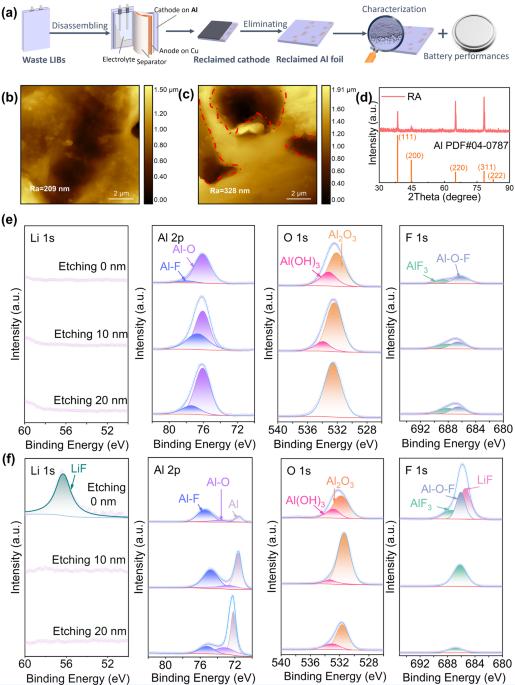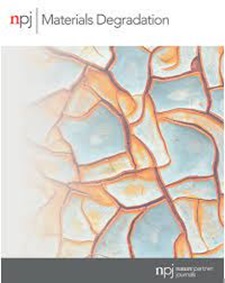锂离子电池中铝集流体的钝化和腐蚀
IF 7.6
2区 材料科学
Q1 MATERIALS SCIENCE, MULTIDISCIPLINARY
引用次数: 0
摘要
最先进的锂离子电池在长期运行过程中不可避免地会受到电极腐蚀的影响,如铝集流体的腐蚀。然而,人们对铝腐蚀及其对电池性能影响的了解还不够详细。铝的钝化、破坏和腐蚀导致固/固界面和电极完整性恶化。此外,F-/Al3+ 的局部扩散带来了不可逆电流,损害了库仑效率(损失 1.14%)。最终,这种行为导致电池容量大面积受损(20%),影响电池性能直至使用寿命。在电池循环过程中,中值电压附近会产生大于 20 nm 的钝化层。当充电电压升高时,钝化层受到新生成的 Al-F-O 颗粒的挤压并发生变形,从而产生应力腐蚀裂纹。随着电压继续升高,钝化层脱落,纳米钝化层材料重新生成。重复上述结果,铝基体不断被消耗。局部腐蚀导致的钝性击穿源于碳酸乙烯的吸附,这与电荷电压高度相关,尤其是在 4.4 V 和 4.8 V 时。研究结果将作为其他先进储能材料电极腐蚀的基准,这对利用界面设计进行电极工程和性能调节至关重要。本文章由计算机程序翻译,如有差异,请以英文原文为准。

Passivation and corrosion of Al current collectors in lithium-ion batteries
State-of-the-art lithium-ion batteries inevitably suffer from electrode corrosion over long-term operation, such as corrosion of Al current collectors. However, the understanding of Al corrosion and its impacts on the battery performances have not been evaluated in detail. The passivation, its breakdown, and corrosion of the Al resulted in the deterioration of the solid/solid interface and electrode integrity. Additionally, localized diffusion of F−/Al3+ brought the irreversible current detrimental to the Coulomb efficiency (1.14% loss). Eventually, the behavior led to extensive capacity damage (>20%) to battery performance until lifespan. During the battery cycling, the passivation layer greater than 20 nm was generated near the median voltage. When the charging voltage rose, the passivation layer was squeezed and deformed by the newly generated Al-F-O particles, resulting in stress corrosion cracks. The passivation layer peeled off, and the nano-passivation layer material was re-generated as the voltage continued to rise. The above results were repeated, and the Al matrix was continuously consumed. The passivity breakdown with localized corrosion was derived from ethylene carbonate adsorption, which was highly correlated to the charge voltages, especially at 4.4 V and 4.8 V. The results will serve as a benchmark for electrode corrosion of other advanced energy storage materials, which is crucial for electrode engineering and performance modulation using interfacial design.
求助全文
通过发布文献求助,成功后即可免费获取论文全文。
去求助
来源期刊

npj Materials Degradation
MATERIALS SCIENCE, MULTIDISCIPLINARY-
CiteScore
7.80
自引率
7.80%
发文量
86
审稿时长
6 weeks
期刊介绍:
npj Materials Degradation considers basic and applied research that explores all aspects of the degradation of metallic and non-metallic materials. The journal broadly defines ‘materials degradation’ as a reduction in the ability of a material to perform its task in-service as a result of environmental exposure.
The journal covers a broad range of topics including but not limited to:
-Degradation of metals, glasses, minerals, polymers, ceramics, cements and composites in natural and engineered environments, as a result of various stimuli
-Computational and experimental studies of degradation mechanisms and kinetics
-Characterization of degradation by traditional and emerging techniques
-New approaches and technologies for enhancing resistance to degradation
-Inspection and monitoring techniques for materials in-service, such as sensing technologies
 求助内容:
求助内容: 应助结果提醒方式:
应助结果提醒方式:


